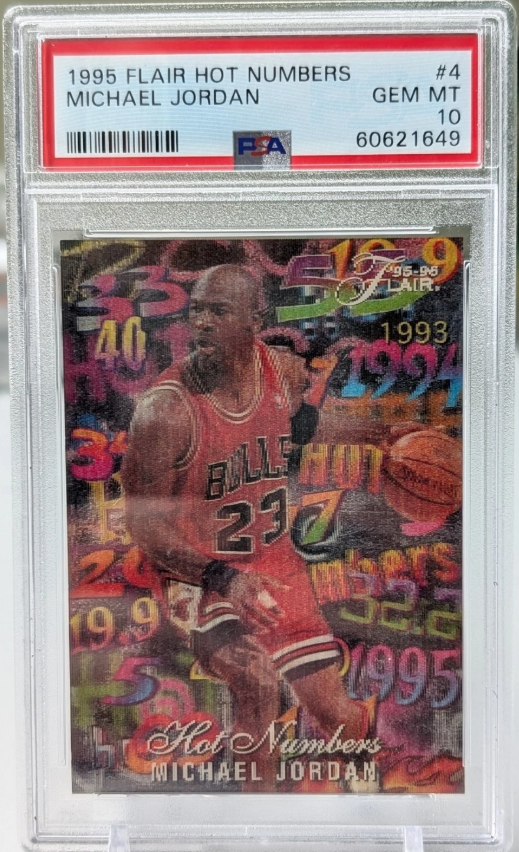In the dazzling world of trading cards, where nostalgia and design innovation meet, few collectibles have achieved the magnetic allure of Michael Jordan’s 1995–96 Flair Hot Numbers insert, card number 4. Revered by enthusiasts and collectors alike, this card does what great pieces of art often do: it demands attention and captivates the imagination even while standing perfectly still. From the moment the light hits its intricately layered lenticular printing, it throws back a visual symphony reminiscent of a brightly lit scoreboard, making the numbers dance and pirouette as you tilt it.
The tale of this flamboyant card begins in what many consider basketball’s golden age—the heart of the Chicago Bulls’ unrelenting 1990s dominance. During this period, Flair, a brand committed to pushing the boundaries of premium card design, was on a mission to prove that paper products could hold their own amidst the ascendant chromium trend. The Hot Numbers insert, which was a 15-card series according to hobby giant Beckett’s guide, represented the pinnacle of this endeavor, blending a three-dimensional lenticular coat with standout designs. The unparalleled flair and scarcity ensured it would become a must-have for collectors fluent in the language of the era’s card culture.
Landing a Hot Numbers insert in a pack was no simple feat, as they appeared only once in every 36 packs. This rarity meant a keen-eyed collector might tear open box after box without ever encountering one. Therefore, possessing the card not only reflects a tangible piece of the 1990s ethos but also a testament to the patience and perseverance of its owner. Those who managed the striking pull were rewarded with a piece that encapsulated the distinct vibrancy of the decade, ready to enhance any showcase with its unapologetically grandeur aura.
The current market treats a PSA 10 graded Hot Numbers card as something akin to a crown jewel. In recent times, sales for these mint condition marvels have clustered around the four-thousand-dollar mark, underlining its continued desirability nearly three decades after it originally graced collectors’ hands. With PSA’s auction history of the card hovering near three thousand nine hundred fifty dollars and other platforms like Card Ladder reporting mid-summer sales peaking at four thousand eight hundred dollars, the financial reassurance it offers is as robust as the visual spectacle it provides. The intersection of pristine condition and eager bidders occasionally elevates its sale price, reflecting the edginess and competitive spirit inherently tied to such a rare collectible.
Condition plays a starring role in determining the card’s market behavior. The lenticular surface, while dazzling, can mask surface imperfections such as faint lines under poor lighting, while the foil-heavy front design may allow edge chatting to go unnoticed. Serious buyers and avid collectors rely on angled shots, reputable sellers, and fresh market comparisons to guide their acquisitions, ensuring they aren’t led astray by overly optimistic photographs. When a copy meets the high standards of sharp edges and well-centered print, it is not unusual for bidding to settle naturally into the familiar four-thousand-dollar territory.
As the saying goes, good design never goes out of style, and the Hot Numbers card is living proof. Its design aesthetic encapsulates the essence of the mid-90s appeal—action and movement portrayed without reliance on overused hologram tricks, resulting in a card that oozes character. This is the card you can recognize across a crowded showroom floor, its geometry and number scheme dancing in a manner no other Michael Jordan insert has quite replicated. For those who grew up in the era, a single glance is enough to evoke a rush of nostalgia, while newer aficionados are introduced to the card’s legacy through stories of Jambalaya clips and Precious Metal Gems.
The contextual framework of its creation by Flair—an attempt to elevate paper products using weight and finish—adds to its timeless charm. The Hot Numbers insert was the needlepoint of this experiment, with a one-in-36 retention rate that made its discovery impactful. This isn’t just a card; it’s a miniature masterpiece with design prowess that extends beyond stock photographs into realms akin to graphic artistry.
For collectors, the card finds a myriad of niches: it fits seamlessly as part of a 90s insert ensemble alongside legendary series like New Heights and Scoring Kings, acts as the flamboyant cousin in a Michael Jordan-specific collection, or offers a solo display that speaks for itself without the need for context. Even completing the entire run of 15 Hot Numbers is an undertaking worth its weight in nostalgia, with each card serving as a snapshot of mid-90s basketball legendhood.
The clarity of current comps provides a straightforward understanding of the card’s value. With PSA 10 auctions indicating approximately four thousand dollars as the mainstay price, punctuated by occasional spikes when a card with exceptional visual impact crosses the block, the card maintains its high profile. Though ambitious Buy It Now listings exist above market valuation, it’s often the open auction space that dictates its real worth.
Discerning collectors know the power of proper condition checks—angled shots and edge examinations reveal truths hidden to the naked eye. The often imperceptible lines affect both market perception and selling price. Success lies not just in owning the card but in recognizing its visual prowess and the era it celebrates.
For the thrill-seekers out there, the prospect of unwrapping a Jordan Hot Numbers still brings out the same evocative reaction as in the mid-1990s: a gathering of awestruck fans, each hoping for their own piece of the spectacular. It captures attention, ignites excitement, and holds its own as a standalone piece or the star of a 90s display.
Owning a Michael Jordan 1995 Flair Hot Numbers insert offers more than a slice of basketball history—it presents a paradox of ephemera and immortality, a harmonious blend of design marvel and market savvy that remains as relevant today as it was the day it left the factory floor. As both a cultural icon and a collector’s prize, it stands as a testament to the enduring allure of the superstar athlete and the decade that made him larger than life.

